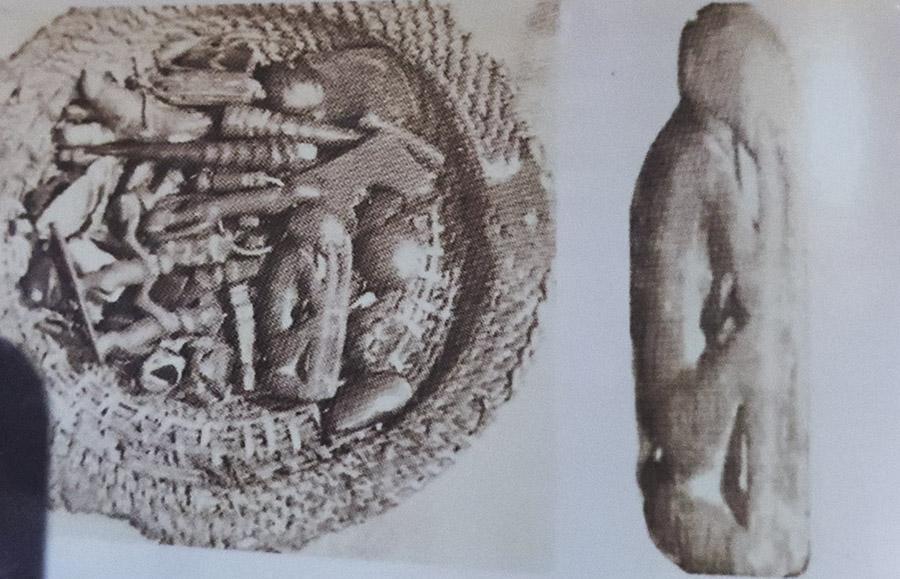Africa-Press – Angola. At a certain point in the history of Angola, the cokwe amulet called “samanyonga” or “kaka”, found in the Dundo Museum, was called “Cokwe Thinker”.
It is said that it was the Angolan anthropologist Henrique Abranches who, in an attempt to find a name for the aforementioned artefact, gave it the name above, based on Patrick Delachaux’s study of the well-known French sculpture “Le Penseur”.
It is possible that the Angolan intellectual’s arguments were based on the fact that “Le Penseur”, initially called “Le Poete”, by its inventor, Auguste Rodin, apparently has some features found in the renowned symbol of national culture.
Even so, well observed, such traces, if they exist, are not seen with the naked eye by a layman and, on the other hand, in the deconstruction of his collection, which the anthropologist Manzambi Vuvu Fernado does below, he concludes that, between both pieces , there are no similarities.
“Le Penseur” is an imposing sculpture in bronze and platinum, which was sculpted in 1880 by the Frenchman Auguste Rodin.
The story goes that the play was conceived as an element of “The Gate to Hell”, inspired by the “Divine Comedy”, a 14th century work by the Italian poet, thinker and philosopher, Dante Alighieri.
In 1888, it was multiplied into several copies, which spread throughout the world.
Patrick Delacahux, who analyzed it, identified it as an allegorical representation of existential philosophy, human introspection and the intellectual act of thinking.
And who will be the “Cokwe Thinker” Samanyonga?
Existing data at the Dundo Museum, Lunda-Norte (Northeast), indicate that Samanyonga, also originally known as “kaka,” is a wooden sculpture, measuring 16 centimeters, from the town of Cingufu, located 30 kilometers from the municipality of Chitato.
It was found, in 1936, by a worker from the former Angolan diamond company (Diamang), now ENDIAMA, who took it from a local divination basket, called “Ngombo ya Cisuka”, cleaned and beautified it.
Repeatedly, anthropologist Manzambi Vuvu Fernando also explained that the amulet had been presented to José Redinha, the first director of the Dundo Museum, who placed it in the institution he had just created, a few years ago.
According to him, it was under the name “kaka” that José Redinha, a Portuguese man of culture, investigated him.
Manzambi V. Fernando, who was also director of the same institution, throughout the 1980s, had been stating that, in the Cokwe tradition, the “kaka” was an object of worship, which represented the spirit of an elder, a guardian with mystical wisdom.
In traditional Cokwe practices, the “kaka” enjoyed the status of being the population’s intermediary in contacts between the living and the ancestors, and they resorted to him for consultations and advice that had to do with spirituality.
Regarding the original position of the object, the Museum curator also describes it as having her hands placed on her cheeks, and considers all other pieces with her hands placed in other places on her head to be unsuccessful replicas.
Alberto Coelho, in an exhibition on the positioning of the sculpture, indicates that the figurine has its head tilted forward and its neck in an elongated position.
In a work he published in Jornal de Angola, on August 20, 2017, entitled “The Attitude of Meditation”, Alberto Coelho reinforces information from the Dundu Museum, which says that the Samanyonga “kaka” was one of the objects in the basket “Ngombo ya Cisuka”, used to invoke the spirits of ancestors
In the Cokwe view of the World, he writes, the “kaka” is the holder of the strength of the spirits of the ancestors.
“The family consecrates him as the defender of the lineage before which he serves as an intermediary between the living and the dead”, highlights Alberto Coelho.
For its part, coinciding with the statements of the two scholars above, the website artenaueropeia published, in 2022, “that the position of the Pensador cokwe who is said to have been found in the Northeast of Angola, had more to do with the analysis of the present, the prediction of the future, or, in general, with the image of an old man who meditates.”
A morpho-anthropological and linguistic approach
Regarding the morpho-anthropological and linguistic approach of the so-called “Cokwe Thinker”, Manzambi Vuvu Fernando, in the introduction to his work “Studies of ethnographic collections in the Museums of Angola – Deconstructing the Cokwe thinker from the Ngombo ya Cisuka”, notes the following: “the work consists of the deconstruction of a sculpture collection at the Dundo Museum, called “Pensador cokwe”, a designation that seems to us to be ethnographic”.
“This identification did not respond to the Cokwe socio-cultural reality, and a morpho-anthropological analysis of the sculpture in reference was carried out, focusing on a linguistic approach, which we believe to be of great importance for the study of collections in museums, thus making a reinterpretation of the collections identified from the perspective of an exotic anthropology”, he says.
Continuing, he explains: “The approach from the perspective of an exotic anthropology seemed more appropriate to studies of the ‘other’, intervening with a multidisciplinary approach – morphology, anthropology, linguistics”, concludes the professor at the Faculty of Social Sciences.
Regarding the change of the name “kaka” to “kuku”, Manzambi Vuvu Fernando clarifies that “kuku” is what gathers consensus from the experts who studied the piece.
“Like kaka, kuku also means elder, and is already accepted by four ethnic groups in Angola, whose languages call it kuku”, he highlights.
It should be remembered that, in 1984, on the occasion of the first national cultural festival held in Luanda, the “kuku”, stolen more than 30 years ago from the Anthropology Museum, was proclaimed a symbol of national culture.
The artefact has also been featured in filigree on the national currency, the kwanza, since its launch in February 1977.
It is part of the collection of the African Union art gallery, in Addis Ababa, handed over to that institution by President João Manuel Gonçalves Lourenço, in February 2018.
For More News And Analysis About Angola Follow Africa-Press






